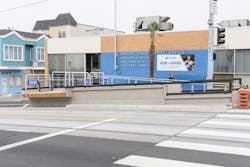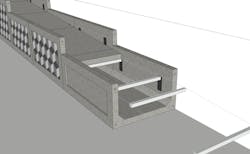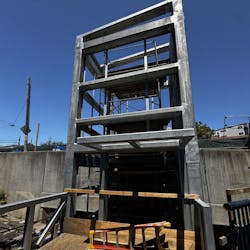ASAP Funding Helps Transit Agencies Accelerate ADA Improvements at Legacy Rail Stations
Nearly four years ago, the All Stations Accessibility Program (ASAP) was signed into law as part of the Infrastructure Investments and Jobs Act, marking the first time federal competitive grant funding was exclusively dedicated to making accessibility upgrades at legacy passenger rail stations.
The program, championed in part by Sen. Tammy Duckworth (D-IL), has played a major role in bringing legacy passenger rail stations into compliance with Americans with Disabilities Act (ADA) standards. The program is authorized to award $1.75 billion through 2026. Since fiscal year (FY) 2022, the program has awarded over $1 billion to help finance capital projects supporting accessibility improvements.
In a few short years, it seems ASAP funding is already having an impact. As reported in Mass Transit’s 2025 Passenger Rail Trends report, 2023 National Transit Database (NTD) Transit Stations data revealed 45% of legacy stations are not ADA compliant compared to 55% that are compliant. This is an improvement from NTD’s 2022 numbers, where 47% of legacy rail stations were not ADA compliant compared to 48% that are compliant.
ASAP jumpstarts station accessibility efforts
Duckworth agrees that ASAP funding has played a “big part” in getting many of these projects done, especially for transit agencies that simply lacked the funding to get started.
“I think ASAP really jumpstarted a lot of these stations. They had plans in place, and they were just not able to get the funding for it and by having the dedicated revenue streams...they were able to execute right away,” Duckworth said.
The program funding is reserved for agencies and government entities that operate legacy rail fixed guideway systems and can only be used to either:
- Repair, modify, improve, retrofit or relocate station or facility infrastructure used by passengers; or
- Develop or modify plans for accessibility projects, accessibility assessments or assessments of upcoming changes to passenger stations or facilities.
For example, funding has allowed Metra to reconstruct a platform, add a pedestrian tunnel and upgrade its audio and visual communication displays at one of its stations. The Maryland Transit Administration is using its funding to draft plans and complete environmental activities for the upcoming renovation of its Martin Airport Station. The New Orleans Regional Transit Authority is applying its funding to help redesign and upgrade its St. Charles streetcar route, including finishing the design and construction of ADA-compliant stops.
SFMTA pilots quick-build approach to construct accessibility improvements
The San Francisco Municipal Transportation Agency (SFMTA) has also benefited from ASAP funding, having received over $4.6 million as part of the FY 2024 project awards to add new platforms, wheelchair ramps and other accessibility improvements on eight stops along various light-rail lines.
Erin McAuliff, SFMTA’s acting director of accessible services, echos Duckworth’s insight on how the program funding has expedited the agency’s ability to bring its stations into ADA compliance. The stops that were awarded funding fall outside of the agency’s 41 “key stations,” which have all been modified to meet ADA compliance. Instead, they fall within “2nd tier” locations that should be prioritized after the key stations are addressed. Of the 15, seven second tier stops have been built. Once the project is completed on the J-Church Line, over half of the second tier locations will be ADA compliant.
“The ASAP funding really is critical there because it helps us address those stops and stations much faster than we would without the additional funding,” McAuliff said. “We've been using local funding for a lot of these projects, and the ASAP funding just helps us close the gap much faster than we would otherwise.”
In addition to the grant’s eligibility requirements, SFMTA used current ridership levels, proximity to key destinations, distance to the nearest accessible stop and coordination with existing Muni Forward projects as guidelines to identify the five stops on the J-Church Line and three stops on the M-Ocean View Line to undergo station upgrades.
"We have several wheelchair accessible ramps that we intend on adding to either existing non-accessible islands or to brand new transit islands that we'll be installing on those projects,” said Ben Volberding, SFMTA project manager, Planning & Project Delivery. “The ASAP funding will give us even more ability financially to add these accessibility features on these projects.”
Just as important to making the stops accessible is ensuring the disruption to service is minimal. To accomplish this, Volberding explains the agency is considering an alternative construction method specifically for installing wheelchair accessible ramps. The goal of this method is to drastically reduce, or completely eliminate, transit impacts associated with installing wheelchair ramps and platforms at above ground stations.
“The approach we're pursuing right now is to use precast concrete in lieu of the traditional cast-in-place concrete,” Volberding said. “So the plan is that we would be able to kind of piecemeal build these accessible ramps away from the rail, and then during non-revenue hour periods, so during overnight operations, be able to drop in these kind of segmented pieces of the accessible ramps, so that the transit impacts are just limited to taking that given stop out of service during construction.”
With this method, a contractor would create precast concrete U-shaped elements that city crews would then drop in on the transit island at a rail stop after service hours. Crews would then add in the slope line for the ramp after marking the grade within the precast elements. A horizontal support piece would then be installed to support the platform. Volberding explains that in this process, they would be able to control the grade of the walkway and platform “without needing to be 100% dialed in on the levelness of the island itself.”
“We’re intending on piloting this here, hopefully in the next six months or so, at the first location on the M Line that's identified in the ASAP grant,” Volberding said.
If all goes smoothly, Volberding wants to roll this out on all Muni Foward projects he oversees.
“Ideally I think we would see it become the new standard for our accessible ramps on our surface-level transit islands,” Volberding explained.
Adding redundancy to underground station accessibility
While SFMTA is working to bring all of its legacy surface rail stops into ADA compliance, the agency is concurrently building redundancy into its underground Muni Metro rail stations.
For example, SFMTA is currently working on adding an additional elevator at its Castro Station. The agency is in the final phase of installing a tempered glass elevator, which was chosen so that station agents can see into it from their booth. Christian Kalinowski, SFMTA project manager, Planning & Project Delivery, explains while this station was on the list to receive accessibility improvements, it was also prioritized because the surrounding walkways weren’t ADA compliant. That led to the project having a larger footprint, extending beyond the immediate infrastructure of the station and into the surrounding plaza area.
Kalinowski explains before the project, buses dropped off riders on the Market Street level, which has a relatively steep slope with no proper path between the buses and the station.
“Part of our project here is also to regrade the area where the buses will drop off, so that somebody in a wheelchair or somebody who just has to use a cane...they could go from the bus right into the elevator,” Kalinowski said. “Then they could take that elevator down to the concourse of the station.”
The project broke ground in the fall of 2023 and looped in the community early on. It was their feedback during the design phase that led SFMTA to regrade the area for the improved bus path. Kalinowski emphasizes that the public can still provide input, noting community feedback is “an ongoing thing.”
Though the project has taken a couple of years, Kalinowski shares the community for the most part is understanding. The project length is in part due to the same goal of reducing service disruptions and keeping the station in service.
“We want to maintain that access for them at all times,” Kalinowski said. “Sometimes that will limit us to overnight working windows when our trains aren’t running.”
However, unlike Volberding’s hope to roll out a repeatable construction approach for wheelchair ramps, Kalinowski explains when it comes to designing for elevators, each site is unique and project specific.
“We have a general idea about how we should construct elevators, but each site is definitely unique because we have different platform height, or do we need a bridge here or there?” Kalinowski said. “Sometimes if we're building inside of a building, we wouldn't do a glass enclosed elevator inside. That also changes quite a bit with the structure or what kind of weights you need to support.”
Ensuring connectivity beyond the station
Whether it’s installing new accessibility features or building in redundancy, SFMTA ensures the project footprint extends beyond the immediate station or transit island. Connectivity is crucial to ensure access; the newly installed elevator at Castro Station wouldn’t have been as usable without regrading and repaving the sidewalks and paths.
Kalinowski explains the city of San Fransico has a building code that requires any city department or private contractor doing work adjacent to curb ramps to construct them according to standards and specifications that ensure ADA compliance. Volberding shares they take the same approach when working on transit islands, coordinating with the public works team on surveying existing ramps and reconstructing where needed to meet ADA standards.
“Some of these projects where we have long corridors of transit improvements we’ll have [many] curb ramps, so we’re developing a working process with public works to go out kind of proactively early in design and do the evaluation of these ramps,” Volberding said.
These types of connectivity improvements between sidewalks and stops or stations are exactly where Duckworth hopes to continue investing in.
“If you're stuck at the sidewalk, and you can't go anywhere, then that doesn't do you any good,” Duckworth said. "It's that connecting the different modes of transportation so that somebody who takes a train into the city can get out of the train station, have a viable sidewalk that will connect them to the bus stop or will connect them to a bike path.”
As Congress starts discussions on the next Surface Transportation Reauthorization, Duckworth shares her plans to look into allocating money for overall accessibility and connectivity between transportation modes. She says another $2 billion is needed for the second five years, noting ASAP is a 10-year project. She also wants to encourage transit agencies to look beyond the physical infrastructure.
“I think right now, correctly, the operators are actually doing the physical upgrades, but I do think that there are other upgrades that are not just about wheelchair ramps and elevators that also need to be fixed that will make these stations more accessible,” Duckworth said. “I think that there are things that could be done for people with vision impairment, for people with cognitive disabilities, especially when it comes to ticketing stations [and] the ticketing machines—all of that can be worked on.”
The U.S. Department of Transportation (USDOT) and the American Public Transportation Association (APTA) have each outlined their own set of priorities for the next iteration of surface transportation funding. While USDOT wants to prioritize accelerating project delivery and reforming permitting, APTA wants to focus on driving economic growth and streamlining collaborative decision-making. For Duckworth, she wants the transit industry to plan for the future.
“I don't want this funding to bring us up to accessibility today and say, okay, we're done for another 35 years, right? We need for future upgrades to be easily upgradable,” Duckworth said. “It may be as part of the architecture or engineering to think into the future. We've got the money to do this, but this is what the next phase would be if we had the money and do some future planning as well.”
Regardless of the amount that is authorized or the potential project requirements that would be eligible for funding in a future ASAP grant, McAuliff stresses “how critical” this type of funding is, especially in this current period of “financial uncertainty.”
“The more financial support we have for these sorts of one-time projects means we can do more of them, or it helps us continue to deliver on that commitment, so it was really exciting to see the ASAP program and see that commitment to just providing really critical services to our city,” McAuliff concluded.
About the Author
Megan Perrero
Editor in Chief
Megan Perrero is a national award-winning B2B journalist and lover of all things transit. Currently, she is the Editor in Chief of Mass Transit magazine, where she develops and leads a multi-channel editorial strategy while reporting on the North American public transit industry.
Prior to her position with Mass Transit, Perrero was the senior communications and external relations specialist for the Shared-Use Mobility Center, where she was responsible for helping develop internal/external communications, plan the National Shared Mobility Summit and manage brand strategy and marketing campaigns.
Perrero serves as the board secretary for Latinos In Transit and is a member of the American Public Transportation Association Marketing and Communications Committee. She holds a bachelor’s degree in multimedia journalism with a concentration in magazine writing and a minor in public relations from Columbia College Chicago.




